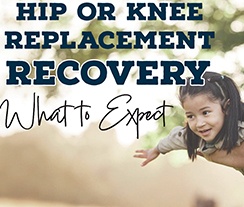
You previously learned about the benefits of Outpatient Total Joint Replacement, but what about after the surgery? What does recovery after a knee or hip replacement look like? What should you expect during the postoperative recovery period? Your physician will provide more specific details, but the tips below will paint a picture of how you can move faster toward a pain-free life!
In the Days Before Surgery
- Prepare your home by removing any tripping hazard for example, area rugs, toys and clutter. You'll need a clear path to the bathroom, kitchen, and bedroom.
- Create an area where you can sit during the day. This should include a supportive chair with arms, a side table, and adequate lighting. Sitting on a low, soft item, sucha s a sofa, could make rising difficult.
- Ensure frisky pets are restrained so they don't get under your feet.
The First Days After Surgery
You’ll be standing and walking within 24 hours after surgery with the help an assistive device and a therapist. Keeping your joint moving after surgery is absolutely essential for a quicker recovery, as is following all your physical therapy exercises. Movement helps prevent blood clots. Although exercising will feel uncomfortable, the pain will lessen over time.
Your therapist will show you how to dress and use the toilet safely during your recovery. If you have moments where you feel unbalanced standing, sit and rest. Do not push yourself and risk falling, and always use your assistive walking device.
Expect some swelling and bruising; this is normal, as is a temporary increase in pain. Applying ice to your surgical area several times a day can help reduce pain and swelling. To further reduce swelling, elevate your knee above the level of your heart by placing some pillows under your ankle (not behind your knee).
If you are on pain medication, be sure to add extra fiber to your diet, and consider taking a stool softener. Avoid using stairs, and make sure your wound stays dry and clean.
Keep In Mind: The first two weeks after surgery are the toughest. Swelling and bruising will peak during the second week, but stay faithful to your range of motion and strengthening exercises. Apply an ice wrap to the joint as needed.
After Two Weeks
You should be able to walk longer distances now, but be sure to use your assistive walking device to help maintain balance and prevent falls. You may feel some numbness and tingling around the incision site; that’s normal. Up and down moods are also normal. If you need to use stairs, be sure they have a sturdy hand rail, and be slow and deliberate as you go up and down. For some people, going down stairs might feel harder.
Three Weeks and Beyond
Pain, swelling, and bruising should be noticeably better, and you should be starting to feel more confident about using your joint and walking longer distances. However, you’ll still need to be careful about your balance. Keep exercising! This time period is where you start seeing the rewards of all that work. Your joint may still swell after activity. That’s normal; applying an ice wrap after activity will help. After Week 4, you should be seeing and feeling a big improvement, especially if you’ve been doing your exercises—and it gets better from here!

